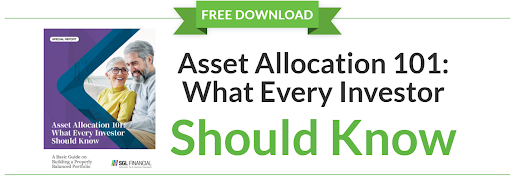Investors: The Differences Between Asset Allocation and Asset Location
by Gabriel Lewit

Should the types of accounts where you invest your assets be an important consideration? Whether you have a 401(k), a traditional IRA, a Roth IRA, or a personal investment account, it can make a big difference. Not all investment accounts are treated the same, especially regarding taxation. This is why you need to create an asset location strategy.
You can think of asset allocation as planning a balanced meal of proteins, carbs, and veggies. The role of asset allocation is dividing up your investment portfolio into different asset categories, like stocks, bonds, or cash. Asset allocation helps to ensure you aren’t over-exposed to one specific type of asset. It is a way to reduce your risk of large losses because you have too much money invested in one asset or asset class.
On the other hand, asset location involves placing assets in the most tax-efficient investment accounts (such as taxable, tax-deferred, or tax-free). Think of it like selecting the best places to store food items to maintain their freshness and quality. For example, you’d store perishables in the refrigerator, grains in the pantry, and spices in a cool, dry cabinet to preserve their flavors.
Today’s blog will look at various asset location strategies to help preserve and optimize your investment results for the new year. At SGL Financial, our Buffalo Grove financial advisors specialize in helping our clients create asset location strategies that can significantly impact their financial well-being over longer periods.
Navigating Market Volatility: The Power of Long-Term Investing
Tax-Deferred Accounts
When implementing an asset location strategy, tax-deferred accounts, such as traditional IRAs or 401(k)s, are particularly well-suited for holding investments that tend to produce higher taxable income and short-term capital gains subject to less favorable tax treatment.
Here are some examples:
- Bonds and other fixed-income securities generate interest income, taxed at ordinary income tax rates. Placing these in tax-deferred accounts can defer the tax liability until withdrawal, potentially at a lower tax rate after you retire.
- Stocks that are long-term holds and pay significant dividends can also benefit from being in tax-deferred accounts to avoid the immediate taxation of dividend income.
- Real Estate Investment Trusts (REITs) often distribute a large portion of their income as dividends, taxed as ordinary income. Holding them in tax-deferred accounts can be advantageous.
- Mutual funds with high turnover rates can generate short-term capital gains that are taxed at higher rates. Placing these in tax-deferred accounts can also defer these taxes until you start taking distributions.
Listen to our podcast, “Strategies to Avoid Paying Zero Taxes on Social Security
Taxable Accounts
A personal or joint investment account that produces taxable income and realized capital gains requires careful consideration. For example, it invests in municipal bonds and stocks that produce long-term capital gains. You should also consider low-turnover investments for these accounts to minimize the number of taxable events.
If you sell an investment at a profit or receive dividends, you must report these earnings on your annual tax return and pay the appropriate taxes.
These accounts offer flexibility with no limits on contributions or withdrawal restrictions, making them suitable for various financial goals beyond retirement savings. However, the tax implications require careful consideration for the investment strategies that determine your holdings.
Examples of other asset classes that are inherently more tax-efficient include:
- Stocks you plan to hold for over a year can benefit from lower long-term capital gains tax rates upon sale.
- Index funds have a low turnover, which reduces the number of taxable events.
- The interest from municipal bonds is often exempt from federal income taxes and sometimes state and local taxes, making them a good choice for taxable accounts.
- Due to their unique structure, Exchange Traded Funds (ETFs) typically generate fewer capital gains distributions than mutual funds, making them more tax-efficient for taxable accounts.
It’s important to note that this asset location strategy requires ongoing attention to the tax implications of buying, holding, and selling investments to adapt to changing tax laws and personal financial situations.
Watch SGL CEO Gabriel Lewit on WGN 9 Discuss Preparing for Taxes
Tax-Loss Harvesting and Asset Location
Tax-loss harvesting is a strategy used to minimize taxes by selling investments that have experienced a loss and replacing them with similar investments to maintain the portfolio’s overall allocation. This allows you to realize a loss, which can be used to offset capital gains taxes or, to a limited extent, ordinary income taxes, enhancing the tax efficiency of your investments.
For example, you hold various stocks in taxable accounts. You notice that one stock declined while another appreciated, creating a capital gain. You then realize a capital loss by selling the stock that declined in value. This loss can offset any capital gains realized in the taxable account during the year, and up to $3,000 can be used to offset ordinary income if capital gains are insufficient. You then purchase a similar stock in the taxable account to maintain the desired asset allocation, ensuring continuity in the investment strategy while reducing the tax bill.
This coordinated approach between taxable and tax-deferred accounts helps optimize the tax impact on investments, making tax-loss harvesting an integral part of an asset location strategy.
How We Can Help
At SGL Financial, we specialize in helping you shape a retirement that is as unique as you are. We want to get to know you and understand your dreams and concerns – what keeps you awake at night.
Our retirement planning includes more than just crunching numbers. It’s about building a retirement that feels right for you, filled with meaning, security, and comfort. Let’s team up and make your dream retirement a reality.

